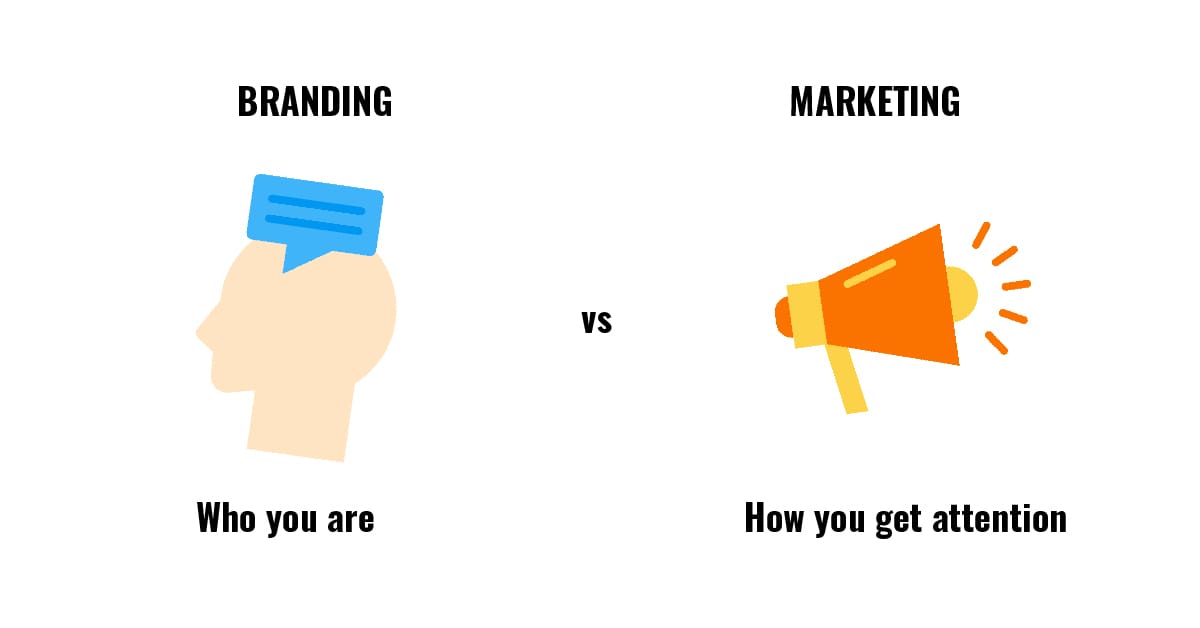If you’re a small business owner, it’s good to have a basic understanding of the various disciplines that help move your business forward, even if they aren’t your specialty. Many business owners are razor-sharp when it comes to accounting and finance. However, when it comes to branding and marketing strategies, they’re often not as clued-up.
In this article, we’re going to help improve your knowledge of branding and marketing. We’ll cover:
- What branding is
- Where marketing comes into play
- How to emotionally connect with your target audience and drive long term-growth
The differences between branding and marketing
Although marketing and branding are closely linked, they are fundamentally different disciplines. It’s easiest to think of your brand as your personality. It’s how the world sees you. Marketing, on the other hand, is how you get the world to see you in the first place. It’s attracting attention.

Both branding and marketing work best when the other is optimised. As an example, it wouldn’t be much use having a strong brand image if you had no way of communicating your value to potential customers. Likewise, your marketing efforts will fall flat if you have a poor brand image.
Elements of branding and how they affect your marketing
Remember, your brand is a living, breathing entity that’s made up of various elements. In order to get the most out of your marketing campaigns, you should aim to keep each of these elements consistent with one another. The goal of an effective brand strategy is to build trust with your target market by delivering a brand promise that’s consistent at every touchpoint.
Let’s say you decide you want your brand to be associated with exceptional customer service. If you were to have phenomenal service during the onboarding phase, but then provide terrible post-purchase service, you’d be sending an inconsistent message. And, most likely, lose the trust (and future business) of the customer who was initially attracted to your commitment to customer service.
Here’s a list of the various elements that make up your brand, and how they influence your marketing:
- Logo: This is your primary identity, it’s how people recognise you. For example, if you were to see a Facebook ad that featured the iconic Swoosh, you’d instantly know it was a Nike ad.
- Colours: Colours supplement your logo as part of your brand identity. When we see the colours red and yellow together, it’s hard not to think of McDonald’s. You can make it easier for consumers to recognise your brand by choosing 2-3 brand colours and using them consistently across your marketing content.
- Brand Voice: This is the tone you use to talk to your customers. Innocent Drinks, for example, have a playful brand voice. But this same voice probably wouldn’t work for a law firm or bank. Your brand voice will inform the copy and messaging you use across your marketing.
- Assets: Brand assets are your brand’s visuals – think photography, illustrations, and fonts. It’s easy to recognise Mailchimp, for instance, by the unique illustration style they use in their marketing.
- Customer service: The way your business interacts with customers will have a big impact on how your brand is perceived. No amount of clever marketing will convince customers you’re good at customer service if you’ve gained a reputation for being bad at it.
- Company Culture: This includes everything from the way you treat your employees to the values you choose to embody. So, if you were to adopt sustainability as a business value, you’d be more likely to attract consumers who also share that value.
- Price: How you price your product or service will also affect how your brand is perceived. Keep in mind, if you have a high-price point, you’ll need to craft marketing content that reflects your value.
A brand guidelines document ensures these elements are kept consistent across marketing channels.
Creating brand equity
If you can get all of the elements above right, you’ll be able to create brand equity. This is when your brand becomes more than just a commodity to consumers and provides value beyond the product.
Coca-Cola, for example, has spent years building their brand equity. So when consumers choose Coke over the competition, it’s not only because it’s the superior product. If you’ve ever found yourself in a boutique cafe, you’ll know there are plenty of tasty soft drinks being produced by independent drinks manufacturers around the globe. Instead, many consumers choose Coke because they’re invested in, and trust, the brand. That’s brand equity in action.
While it’s not always easy to build brand equity, it’s worth putting effort into it. Brand equity is one of the key factors consumers consider when deciding between you or your competitors. It also inevitably leads to brand loyalty, which keeps your business profitable and sustainable in the future.
While I could write an entire book on what it takes to build brand equity, to keep things concise, there are 2 key factors to focus on: strengthening your brand and building awareness.
The first can be achieved by following the steps listed in the section above. When you know who you are and your behaviours and communications materials are consistently in line with that, you’ll naturally build a stronger brand.
Building awareness is trickier – it involves a thorough understanding of your audience and the marketing channels you need to utilise to reach them. Getting this step right relies upon committing to a solid long-term marketing strategy.
Traditionally this would have involved newspaper, TV, radio, and billboard advertising. But, although these can still be relevant, these days it’s more about digital marketing channels such as search advertising, social media, and programmatic display ads.
It’s important to keep in mind that this is a long-term strategy. We often see business leaders dismiss the effectiveness of digital marketing campaigns when they don’t see results within the first few months. But, just like any relationship, building a relationship with your customers takes time and commitment.
Those who stick with their strategies beyond the six-month mark, tend to see significant improvements in both awareness and sales performance over a longer term. Consistent and effective marketing has raised their brand awareness – people know they exist and are therefore more likely to buy from them.
Next steps
As a branding and marketing agency, we’re often approached by business owners who want to find ways to either improve growth or reverse declining sales figures. While we employ a variety of marketing tactics to help them do this, we’ll almost always start the process with a brand workshop. This helps us craft a brand image that’s more emotionally appealing to consumers, making any marketing strategies we implement much more effective and likely to succeed.
If you’ve found that the growth of your business is starting to stagnate, our advice is to start by taking an honest look at your branding. Then, once you’ve got a brand that’s in tune with your audience, you’ll be better equipped to capture attention and get numbers moving in the right direction.
For further reading, it’s worth checking out our guide to creating an appealing brand or our article on how to fix a broken brand. Finally, if you’d like some help getting more mileage out of your brand image, get in touch today.






